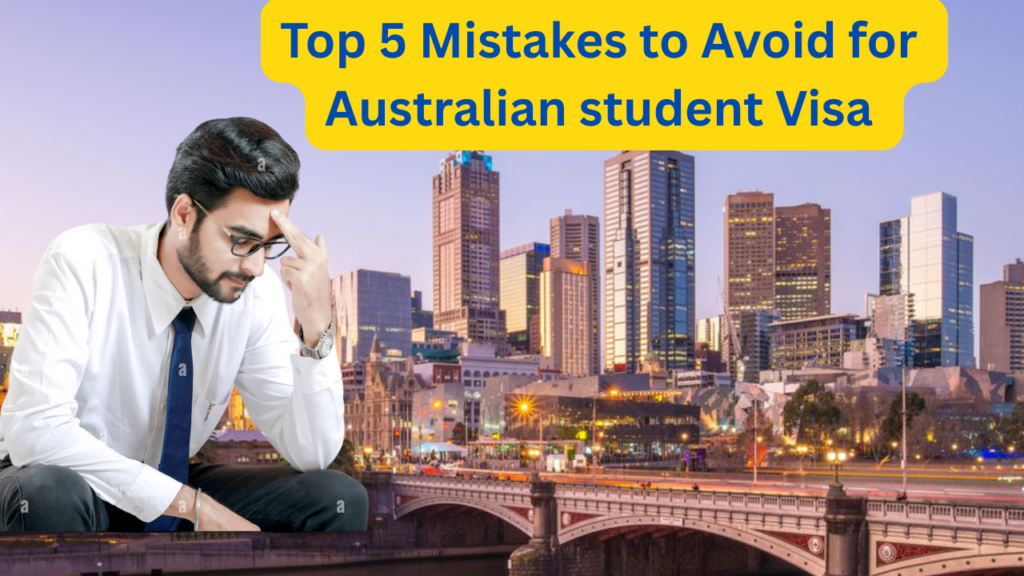Applying for an Australian student visa (Subclass 500) is a big step toward achieving your dream of studying in Australia. However, even small mistakes during the application process can lead to unnecessary delays or even visa refusal. In this blog, we’ll highlight five common mistakes and how to avoid them ensuring your journey to Australia starts smoothly.
One of the most common reasons for Australian student visa rejections is submitting missing or incorrect documents. The Australian immigration department requires all paperwork to be accurate and complete. To avoid this mistake, make sure you double-check that you have all the required documents. This includes a valid passport, Confirmation of Enrolment (CoE), a strong Genuine Student (GS) Statement, proof of financial capacity, English test results, and Overseas Student Health Cover (OSHC). If your documents are in a language other than English, get them translated. Use the official Australian Government Australian student visa checklist before submitting your application.
Your GS statement shows your intention to study in Australia genuinely. A vague or copied statement can lead to Australian student visa refusal. To make it strong, clearly explain your study plans, career goals, and reasons for choosing your course and institution. Also, highlight your plans to return home after completing your studies. Be honest and avoid using generic templates.
You must prove you can support yourself financially in Australia. Unclear or incomplete financial documents may lead to Australian student visa refusal. Provide recent and genuine bank statements or a sponsorship letter if someone is funding your education. The required living expenses are currently AUD $29,710 per year. Include extra proof if you’re applying with dependents. Refer to the official financial capacity guidelines for detailed requirements.
English test scores are essential for Australian student visa approval. Failing to submit the right score or using an expired result can lead to rejection. Check your institution’s language requirements and take one of the approved tests—such as IELTS, TOEFL iBT, PTE Academic, or Cambridge English. Make sure your scores are valid at the time of submission. If needed, consider taking an ELICOS (English Language Intensive Courses for Overseas Students) course.
Many students delay their applications and end up missing their intake or facing last-minute issues. Start your application process at least 3 to 6 months before your course begins. Always refer to the Australian student visa processing times on the Australian immigration website and give yourself enough time to prepare your documents properly.
Final Tips for a Smooth Student Visa Application
Double-check all the information you provide. Always be honest and consistent. Seek professional guidance from education or migration consultants if needed. Respond quickly to any requests from immigration authorities and stay updated with the latest policy changes.
Applying for an Australian student visa is a vital step in your international education journey. By avoiding these five common mistakes, you can increase your chances of a smooth and successful Australian student visa approval. With proper planning and guidance, your dream of studying in Australia is within reach.
Frequently Asked Questions (FAQs)
1.How much bank balance is required for an Australian student visa?
You need to show enough funds to cover your tuition, living expenses (currently AUD $29,710/year), and travel costs.
2. How long does it take to process an Australian student visa?
Processing usually takes 4 to 8 weeks. Apply at least 3–6 months in advance.
3. What happens if my Australian student visa is refused?
You’ll receive a refusal letter explaining why. You can correct the issues and reapply, or appeal in some cases.
4. Can I work while on an Australian student visa?
Yes, Subclass 500 visa holders can work up to 48 hours per fortnight during study terms.
5. Can I apply for permanent residency (PR) after studying in Australia?
Yes, many students move to Temporary Graduate Visas (Subclass 485) or Skilled Migration pathways after graduation.

